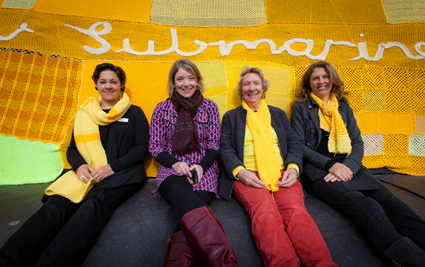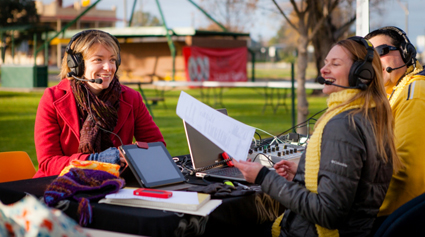 |
Murray Arts Staff (L-R) Jo Bartels, Karen Gardner, Vivien Naimo and Carolyn Martin Doyle (Maggih Coates not pictured) photo Natalie Ord, Manifeasto Photography |
Gardner tells me she fell in love with theatre when she was 16 and did a degree at Charles Sturt University in Bathurst—“So I’ve always felt a connection to regional arts and I’ve always been quite passionate about being able to experience the arts in regional communities.” She subsequently worked on arts events in the Millennium and Olympics cultural celebrations, but “when the job came up at Murray Arts my husband and I moved from Sydney to be here. And it’s wonderful.”
Give me some idea of what Murray Arts does in the areas of facilitating, nurturing and connecting.
I see us having a dual role; one of these is about building community capacity and that’s almost twofold in that it’s about supporting and nurturing artists to live in regional areas. It’s also about building the capacity of the community to be involved, to facilitate and undertake their own arts projects. So there’s our community capacity but then I very much see us having a role as creators and producers of work as well. We undertake our own arts projects and try to make them happen in our region. There’s a whole lot of other stuff but those are the two key areas [as well as] an information and communication role, an important part of what we do—newsletters, the website and social media. And then we run a lot of partnership projects as well; workshops—all those sorts of things.
Let’s talk about some of the projects that you’ve initiated or are on the way.
Last year we organised a big project called the Holbrook Yellow Submarine. We yarn-bombed the HMAS Otway in Holbrook, which is a full-sized submarine [donated to the town which was named after a British submariner. Eds] and we made it yellow with knitting. We got a lot of coverage—national and international—and donations. It was a huge project that connected a very small community to the whole world. It crossed ages and timelines, crossed the nation, crossed the world. And I think what we got most out of it was people’s connection to place. When people sent in their donations of yellow wool—because we were relying entirely on people to contribute to this project—it would often come with a little note. Some people just thought it was a fun and quirky idea but lots of people had a connection to the submarine in some way. They had relatives who’d served on the submarine. Someone said, “When he was learning to walk, my son took his first steps on the HMAS Otway.” It offered such a lovely insight into the lives of a community.
Who were the artists involved?
We were the project managers and we had three artists (Libby Alexander, Donna Pinder and Michelle Oxley) overseeing, making sure the installation of the submarine looked fantastic. We had thousands of donations. One was 17 metres long. Others sent tiny squares. And they were all sewn together by a small army of volunteers and then installed. Just to give you some idea of the scale, the submarine is 90 metres long by 8 metres high and the whole thing was yellow!
What other projects have you taken on?
Last year we produced We Are All Made of Stardust—an arts and science project linking astronomy and charcoal drawing. We arranged a series of science lectures on the night sky and invited an Aboriginal storyteller, Leonie McIntosh, to come in and talk about Indigenous interpretations of the night sky. Then we had artist Zhen Chew do charcoal drawing and create a series of animations to re-animate the stories that people had learnt through their night sky viewing. Western interpretations of the night sky are about the constellations themselves whereas Indigenous interpretations are also about the black space in between. So you get nice contrasts in meaning. To get those stories across and re-tell them, the community participated in these big charcoal drawings workshops.
And you had a good turn-out?
Huge! This time we went to some of our smaller communities where we hadn’t worked before. A particularly memorable one was out at Savernake, which is a couple of hours from Albury. We told one person that we were coming and 70 people turned up. Savernake is very much a farming community. There’s a school, a community hall and that’s about it. Some drove from an hour away to be part of the project. The whole school took part, all 16 of them. It was such a beautiful community event. We put on a barbecue and took the telescopes out and, of course, the night sky out there is just huge. It was just a really great community response to that project
 |
Karen Gardner, Bronwen O’Shea (ABC Goulburn Murray) and Chris Coleman (ABC Riverina) photo Natalie Ord, Manifeasto Photography |
That’s right. We do a lot of professional development workshops as well but one of the big projects we have coming up this year is a transportable art gallery. We’ll have a small gallery set-up that is completely able to fit either in the back of a car or be towed by the Murray Arts car. Again, we’ll be able to take that to some of our smaller communities where people wouldn’t necessarily come in to see a show at Albury Art Gallery or they might feel intimidated going into a [conventional] gallery space. We’re also working on getting some nice digital content to support a curated exhibition of contemporary art from our region.
Something that extends the life of the exhibition once it’s moved on?
Yes, and also makes it more interactive. We’re working with an app that when you put it over the artwork will allow you to take a tour of the artist’s studio or to see an interview with the artist.
What are the other principle activities you’re involved in?
Another of our key activities is around Aboriginal arts development: we have a part-time Aboriginal Officer, Maggih Coates. Over the last few years we’ve been working very closely with Aboriginal artists to provide them with opportunities to exhibit and sell and create profiles for themselves. We arrange an annual group exhibition and then support individuals as we go along. One thing that’s on our agenda for this year is moving our office and having a shopfront that will be a permanent exhibition and sales place for local Aboriginal artists. It’s become very obvious is that there’s no place to buy Aboriginal art in our region. That’s a real gap in the market and this space will meet that need.
You have Flying Fruitfly Circus and Hot House Theatre but what’s the region like in terms of artistic density?
I think we’re very blessed. As well as those professional companies you’ve mentioned we’ve got the Murray Conservatorium, Albury Regional Gallery, which is under re-development but there’s also Arts Space Wodonga. We have two performing arts venues as well. So in terms of infrastructure we’re very lucky. We also have a lot of practising artists, probably mostly visual artists, in our community. I think one of the challenges for us is that while we do have two universities, neither offers a specialised arts degree any more. So in terms of actually bringing new artists into the region at tertiary level, especially at that cutting edge/experimental level, that’s something that’s not happening.
There are also the cuts to TAFE, which are problematic for everyone everywhere.
That has definitely affected our region as well. TAFE is doing the best they can do and it’s not that we don’t have any new or emerging artists that are coming through. I think it’s that ‘pushing the boundaries’ stuff that universities are able to do and bringing new people in—and then they stay. That’s what’s really critical. What we try to demonstrate to artists is that you don’t need to live in the city to have an arts career, an arts practice. It’s something we try to showcase, to provide support for those artists here.
What about people with disabilities?
As producers, a few years ago, Murray Arts did a project called The dis/assemble Dance Project for dancers with and without disabilities. We have an amazing choreographer, Tim Podesta, who works internationally and just happens to live here. He choreographed these works with his full-time dance students and others who had been working with Margot McCallum—another amazing dancer we have here—for five or six years prior to their coming into the program. Although that project as a whole doesn’t exist any more, its legacy lives on in some of those dancers with disabilities now attending Tim’s studio and Margot continues to work with a group of dancers who perform. Albury City has just recently done a project, which was a collaboration and mentorship involving five artists with disabilities and five without. They produced some amazing pieces. So, yes, there are lots of things happening.
You’re covering a lot of council areas and a very big and diverse population. Is there a sense of cohesion between all the different agencies? And you’re straddling a state border as well.
We’re unique in terms of regional arts and I think it’s symbolic of the region itself in that it really is a cohesive border community. We have a health system that works cross-border—Albury-Wodonga Health. The community sees itself very much as a region. And I think we’re incredibly lucky that the councils are very open to working with one another. We’ve just been a partner in a NSW project that got Museums and Galleries funding. It’s a partnership between Murray Arts and our three NSW communities to explore identity through community museums. And then we’re working with three of our Victorian councils to pull together another project. All the cultural development workers come together on a pretty regular basis.
So the councils have their own arts workers?
Some do, some don’t. The two big councils of Albury and Wodonga have cultural teams and a cultural development officer. One of our other councils has a cultural development officer; one has a community development officer. There are two smaller councils that used to have community development officers but those positions haven’t been replaced. There’s a very collegiate atmosphere and people are not too possessive about ideas.
What are the kinds of things you long for? You’ve already talked about the need for specialised arts degrees at universities and a wish that TAFES were better off.
They would definitely be on the wish list. I think we would love to see some kind of permanent Indigenous cultural centre. We’re somewhat on the way to that, but it doesn’t really have the funding to operate in a full-time professional capacity.
I would love to see more cutting edge artists choosing to live in regional areas, to explore their practice here. With the NBN and social media artists might see that there is a lot that regional areas have to offer.
Murray Arts, www.murrayarts.org.au
RealTime issue #125 Feb-March 2015 pg. 26-27
© Keith Gallasch; for permission to reproduce apply to [email protected]








 back
back